Quick Airline Information:
✈Airline IATA* code: UA
✈Airline ICAO* code: UAL ✈Founded: 6 April 1926, (Formerly as Varney Air Lines)
✈Website: www.united.com✈Alliance: Star Alliance✈History
✈Operations and Destinations 🌍
✈Fleet ✈️
✈Photo Slide 📷✈Safety Video 🎬
✈Airline reviews ⭐
*IATA: (International Air Transport Association)
*ICAO: (International Civil Aviation Organization)
History Menu:
United Airlines was the creation of aviation pioneer William Boeing who started out in the airplane business in 1916. His Boeing Airplane Company, as it was then called, achieved the first international postal delivery in 1919 and he went on to establish United Aircraft Corp. in 1928. It was this UAC that acquired mail and passenger service operator Pacific Air Transport on 1 January 1928, then, renamed Boeing Aircraft & Transport Co, merged with Pratt & Whitney Aircraft in early 1929 to form United Aircraft and Transport Corporation (UATC).
After a series of acquisitions, comprising Stout Air Services, America's first scheduled passenger services carrier, on 29 April 1929; the nation's first scheduled service (mail only) operator Varney Air Lines in early 1930 and, finally, National Air Transport (a large Chicago-based mail-only carrier) on 7 May 1930, it lead the company on March 28, 1931, to form the corporation United Air Lines, Inc. United Airlines makes the claim to be the oldest commercial airline in the United States by its Varney acquisition. (Varney was founded by Walter Varney in Boise, Idaho. It flew the first contract air mail flight in a Swallow biplane from Varney's headquarters in Boise, Idaho, to the railroad mail hub at Pasco, Washington, on April 5, 1926).
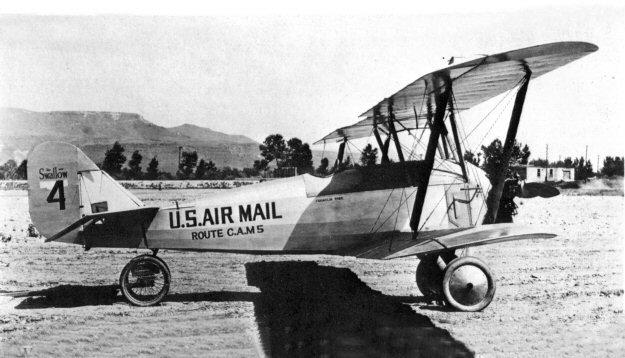
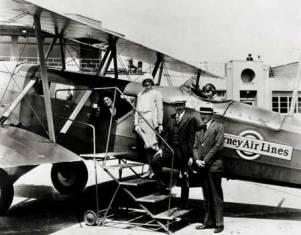
Varney added a Breese-Wilde Model 5 and replaced its original Swallows with C-3 Stearmans and thereafter upgraded as new equipment became available. Subsequent aircraft included the larger M-2 "Bull" Stearman and the Boeing 40 dedicated mail planes, and finally the more modern Boeing 247 twin-engine monoplane. Arriving in 1933, the 247 greatly expanded Varney's ability to carry passengers as well as mail. For the first time passengers could fly across the US without an overnight stop or changing planes. In 1930 United Air Lines introduced the worlds first airline stewardess.
Through its string of successful acquisitions, by 1930, United Air Lines provided coast-to-coast passenger and mail services. Following the Air Mail scandal of 1930, the Air Mail Act of 1934 banned the common ownership of manufacturers and airlines. UATC was broken into three separate companies. UATC's manufacturing interests east of the Mississippi River became United Aircraft (the future United Technologies), while its manufacturing interests west of the Mississippi became Boeing Airplane Company. The airline interests became United Air Lines. The airline company's new president, was William A. Patterson, who remained as president of United Airlines until 1963.
United's early routes, formed by connecting air mail routes, was east-to-west from New York City via Chicago and Salt Lake City to San Francisco, and north-south along the West Coast. The early connections became the basis of United hubs in Chicago and San Francisco and later in Denver and Washington, D.C. These remain United's principal hubs.
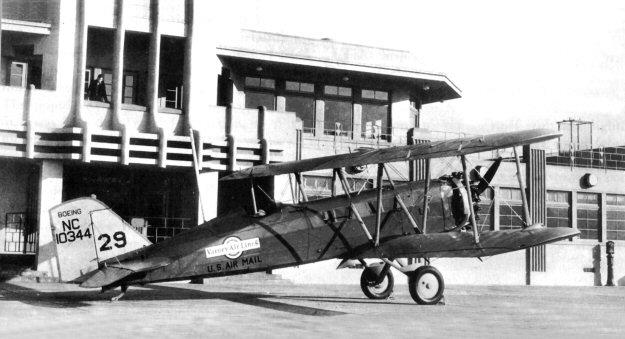
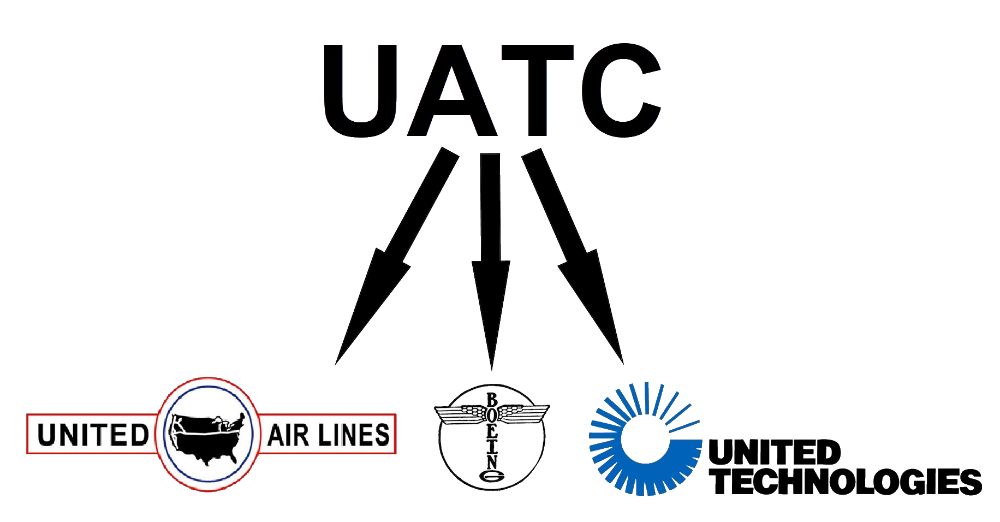
Under William A. Patterson’s leadership from 1934 to 1966, United Air Lines excelled at developing domestic service. Its pioneering coast-to-coast route from New York to San Francisco via Chicago became United’s signature “Main Line.” Its Mainliner fleet of propeller aircraft DC-3 carrying ever-increasing passenger numbers as air travel rivaled the railroads, and the silver airplanes with red, white, and blue markings became familiar sights in the sky.
During World War II United-trained ground crews modified airplanes for use as bombers, and transported mail, material, and passengers in support of the war effort. Post-war United benefited from new technologies (like the pressurized cabin which permitted planes to fly above the weather) and a boom in customer demand for air travel. This was the period in which Pan American Airways revived its Pacific route system that would later be acquired by United. United’s service extended to Hawai’i in 1947.
By 1947, United’s fleet continued to evolve, first with the Douglas DC-4, and then with the DC-6, which introduced pressurized cabin service for passengers. The DC-6 could also fly coast to coast, only stopping in Lincoln, Nebraska. In the next decade, United’s fleet included DC-6s, DC-7s and Convair CV-240 aircraft.
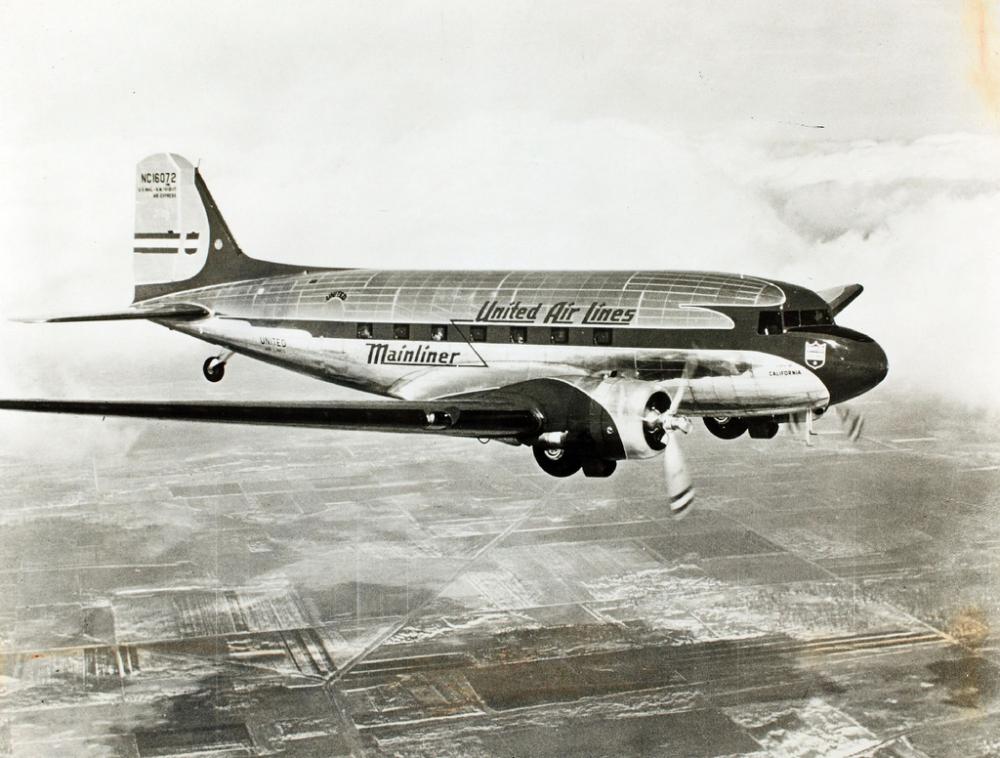
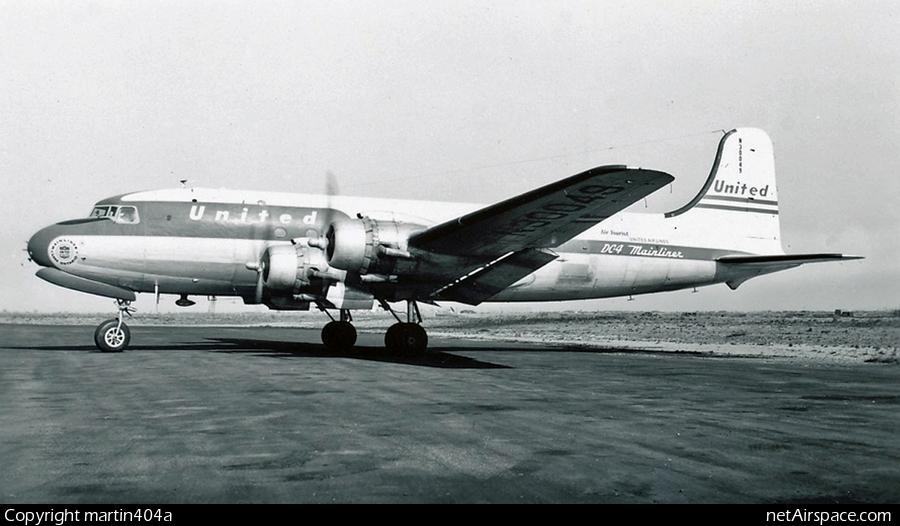
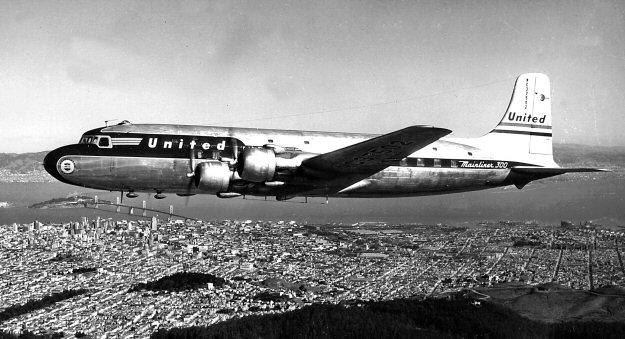
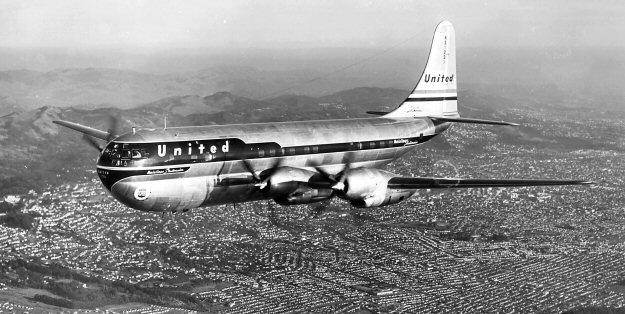
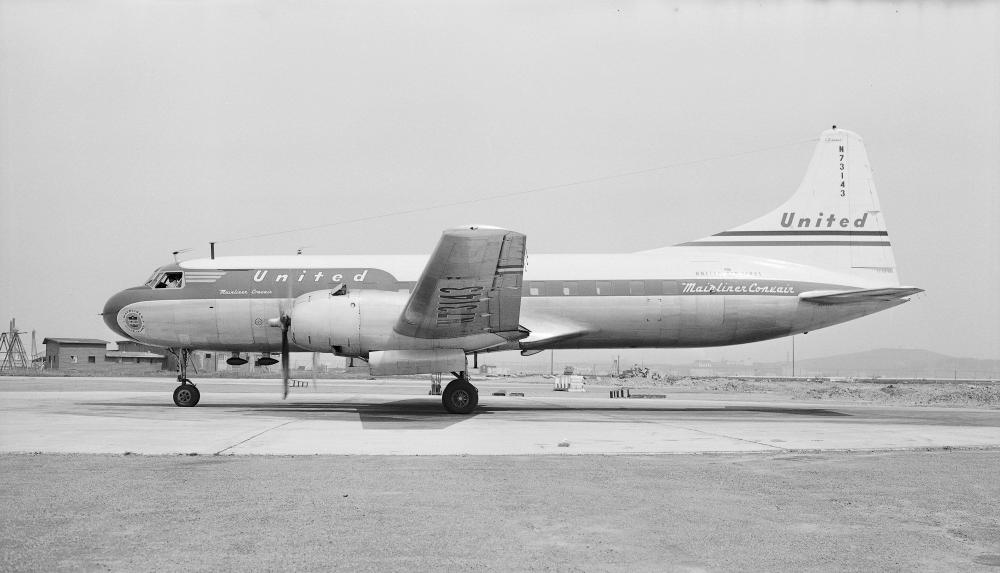
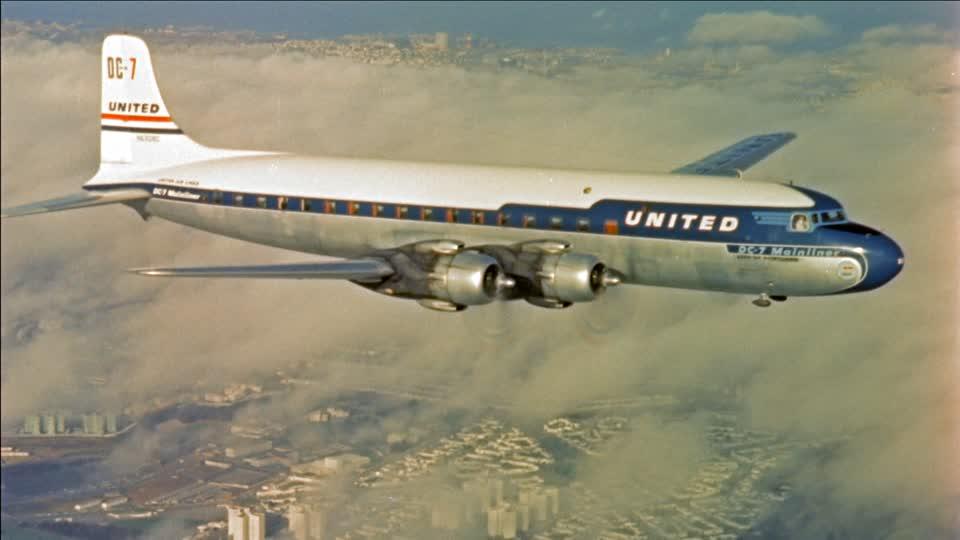
In 1954, United became the first airline with flight simulators that had visual, sound and motion cues for training pilots. During the 1950's, after a series of fatal accidents , it helped pave the way for modern Air Traffic Control. Also in 1959, United received its first Douglas DC-8, its first jet aircraft. United ended up buying the Douglas DC-8 instead of the 707 and became the first airline to fly Boeing's four-engine, shorter-haul 720 jet.
.jpg)
.jpg)
United merged with Capital Airlines on June 1, 1961, displacing rival American Airlines as the world's second largest airline behind Aeroflot of the Soviet Union. The merger with Capital resulted in United operating the British-manufactured Vickers Viscount which was the only mainline turboprop aircraft ever flown by the airline. Also in 1961, United began operating French-manufactured Sud Aviation Caravelle jetliners and was the only U.S. airline ever to operate the Caravelle in scheduled passenger service. In 1968 the company reorganized, creating UAL Corporation with United Airlines as a wholly owned subsidiary.
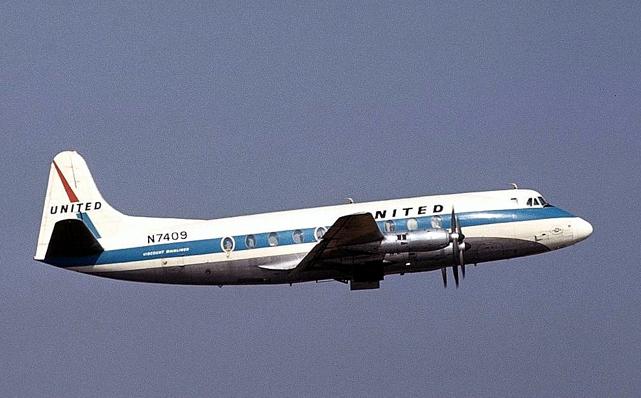
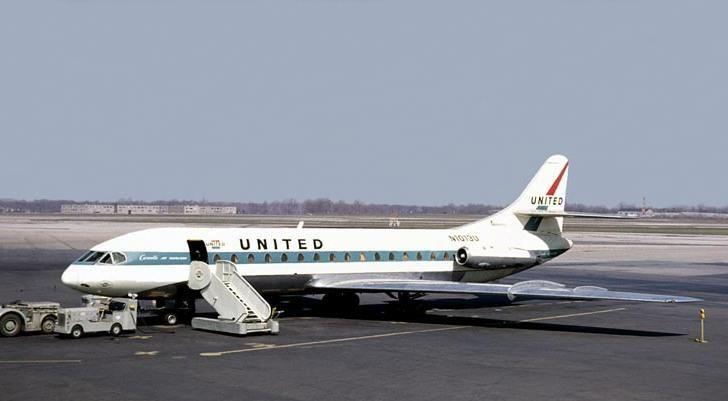
Boeing rolled out the three-engine 727-100 jet, and United began flying the aircraft in 1964. In April 1965, United placed an order for 66 aircraft and options on another 39 with Boeing, making it the largest commercial order ever made by an airline at the time. In 1968 United Airlines was the launch customer for the Boeing 737-200, which made it the aircraft of choice for short haul services from then on.
United took delivery of their first Boeing 747s in August 1970, initially operating them on longer routes within the United States. A year later, United, along with American, were the launch customers for the McDonnell Douglas DC-10, which for many years served as a workhorse in both airlines' fleets. United sought overseas routes in the 1960s, but the Transpacific Route Case (1969) denied them this expansion; it did not gain an overseas route until 1983, when they began flights to Tokyo from Portland and Seattle. After years of focused work to bring about deregulation, the 1978 Airline Deregulation Act became law.
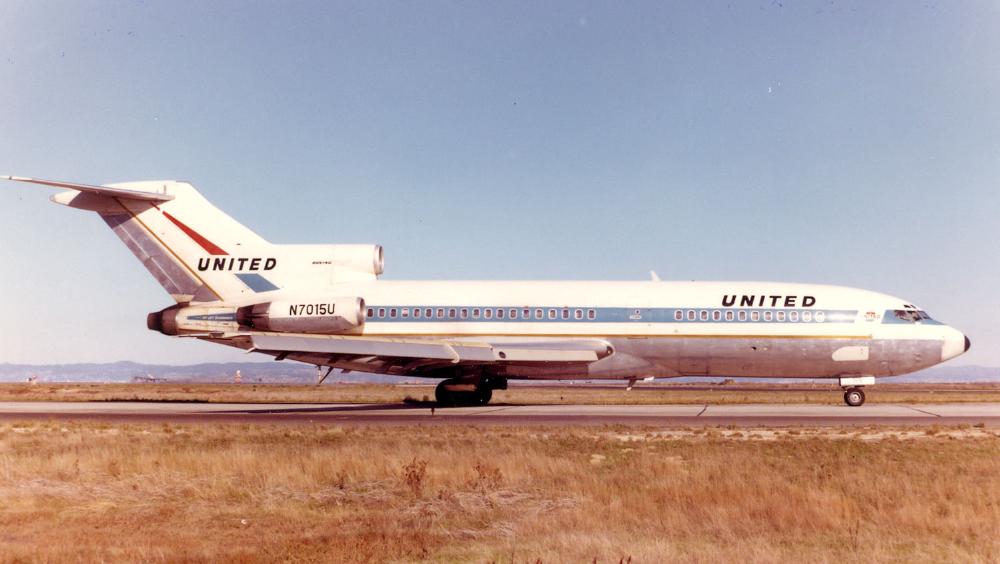
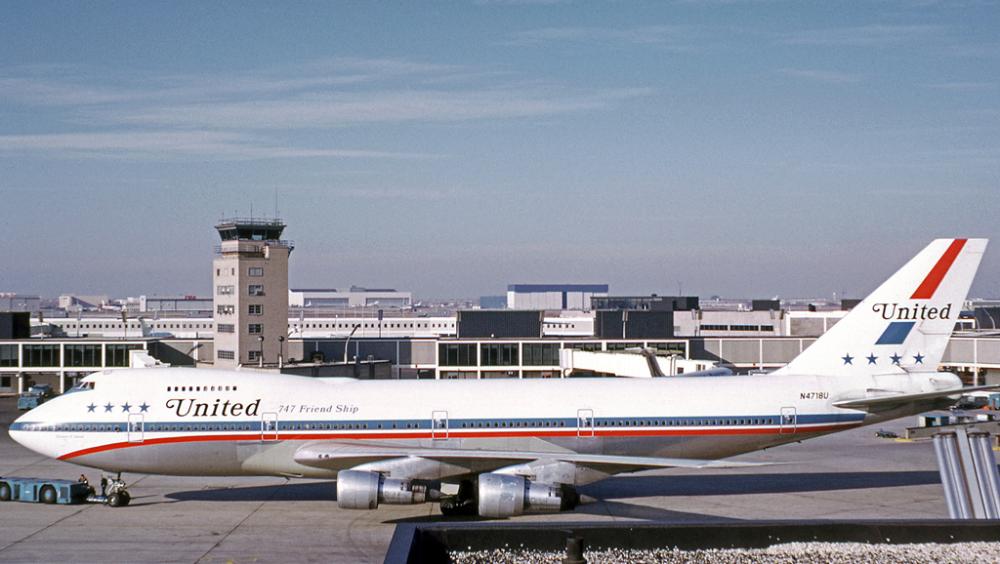
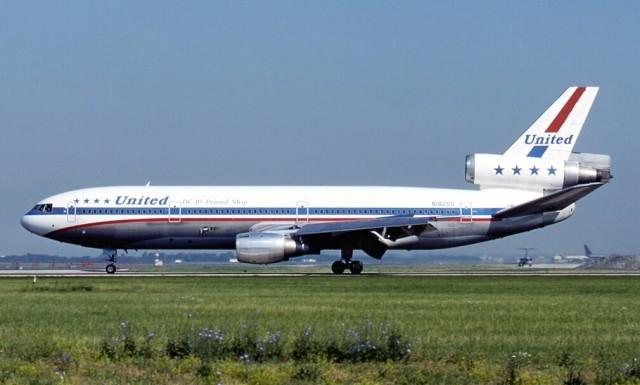
In 1973, the airline commissioned designer Saul Bass to develop a new logo and livery. At the time, there was no real logo for the airline and Bass noted that the brand direction was not clearly evident. The "tulip" logo of colored stripes representing overlapping letter "U"s was in use at the beginning of 1974. The "Rainbow" (or "Saul Bass") livery, which was the first to feature the "tulip", had a primarily white fuselage, with red, orange and blue stripes along the "cheatline". This livery remained in use for 19 years, the Bass branding would remain until early 1993.
In May 1981, one week after rival American Airlines launched AAdvantage, the first modern frequent flyer program, United launched its Mileage Plus. In 1982, United was the launch carrier for the Boeing 767-200, receiving its first 767- 200s on August 19. In 1985, United agreed to buy the ailing Pan American World Airways entire Pacific Division, Boeing 747SPs, and L-1011-500s, and flight crew staffs for $750 million. By late 1986, United flew to 13 Pacific destinations, most of which were purchased from Pan Am.
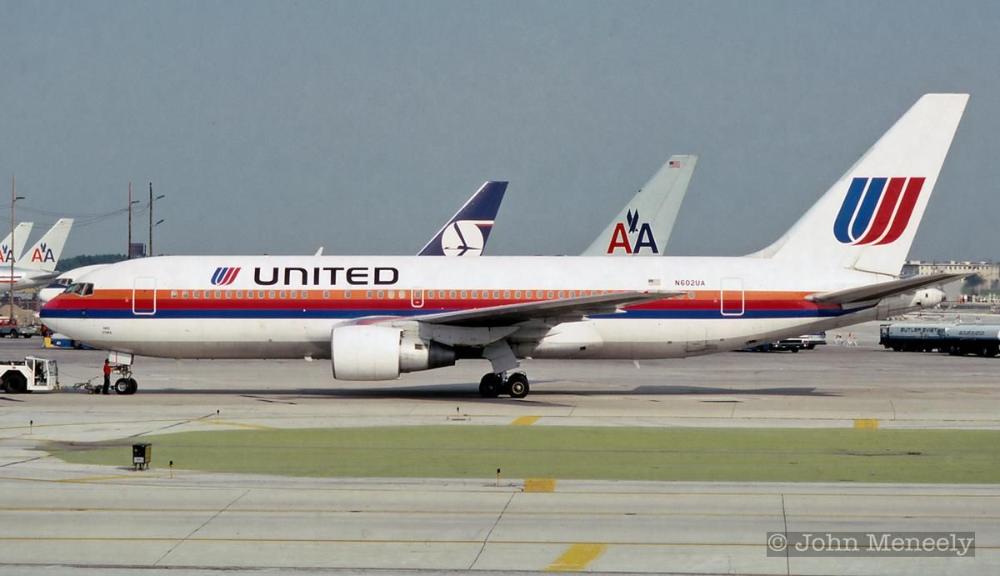
In 1984, United was the first airline to serve all 49 states with commercial airports when it started flights to Atlanta, Nashville, Memphis, Little Rock, Fargo, Casper, Jackson, and Charleston. The airline grew it's fleet with the introduction of the Boeing 747-400 in 1989, to replace older models and open up new markets with the extended range of the "jumbo". For short haul flights, it also received the Boeing 737-300 and 737-500 in 1985 and 1990 respectively.
The decline of Pan American World Airways offered good opportunities for other airlines; in 1991 United purchased Pan Am's routes to London Heathrow Airport. In direct negotiations with the UK government United also obtained rights to fly to Heathrow from Chicago. However, the aftermath of the Gulf War and competition from low-cost carriers led to losses. In 1992 United purchased now-defunct Pan Am's Latin American and Caribbean routes and Miami gates, but United allowed months to elapse between Pan Am's demise and its launch of service.
At the request of then-CEO Stephen Wolf, in 1993 United completely revised its branding and livery, to a primarily grey and dark blue fuselage, with blue stripes on the tail. A custom Times New Roman font, reading "UNITED AIRLINES" in white, replaced Saul Bass's previous lettering style. The familiar "tulip" logo remained, although slightly smaller.
In 1994 United's pilots, machinists, bag handlers and non-contract employees agreed to acquire 55% of company stock in exchange for 15% to 25% salary concessions. United used the opportunity to create a low-cost subsidiary, Shuttle by United, in an attempt to compete with low-cost carriers. In 1995, United became both the launch customer of and first airline to operate the Boeing 777, and had significant input on its design.
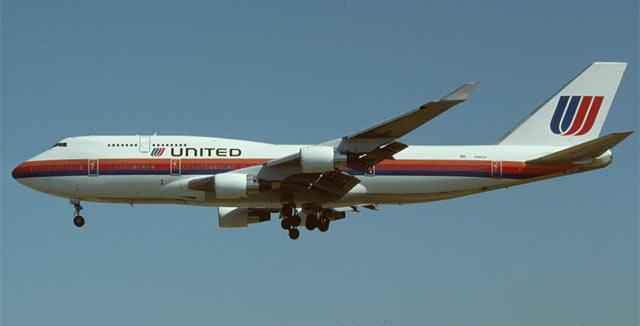
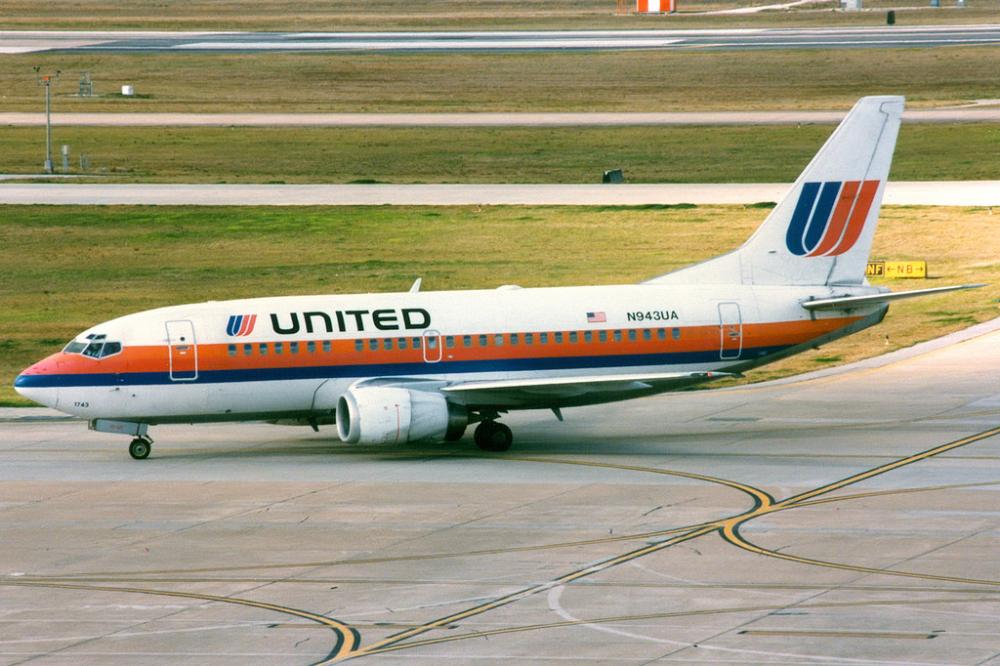
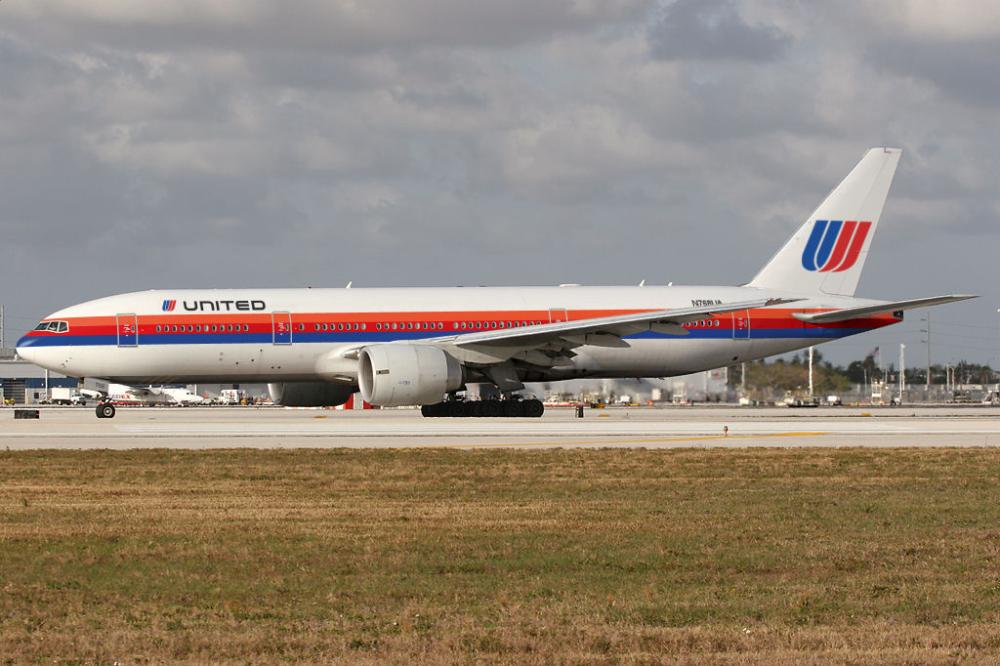
During the 1990's United received its first European made aircraft from Airbus, the A320 in 1993 and the A319 in 1997 to extend its competitiveness and replace older B737. Also, in 1997, United co-founded the Star Alliance with Air Canada, Lufthansa, Scandinavian Airlines and Thai Airways. That same year, United opened its Southwest US hub at Los Angeles International Airport.
In 1998, Delta Air Lines and United introduced a marketing partnership that included a reciprocal redemption agreement between SkyMiles and Mileage Plus programs and shared lounges. This scheme allowed members of either frequent flier program to earn miles on both carriers and utilize both carriers' lounges. Delta and United attempted to form an even closer codeshare relationship, but this deal was effectively killed by ALPA (unions). The marketing partnership ended in divorce in 2003, but paved the way for a future alliance with US Airways. In May 2000, United announced plans to acquire competitor US Airways in a complex deal. The offer drew immediate scorn from consumer groups and employees of both airlines. However, the Department of Justice barred the merger on antitrust grounds in July. The two airlines subsequently formed an amicable partnership that led to US Airways' entrance into the Star Alliance.
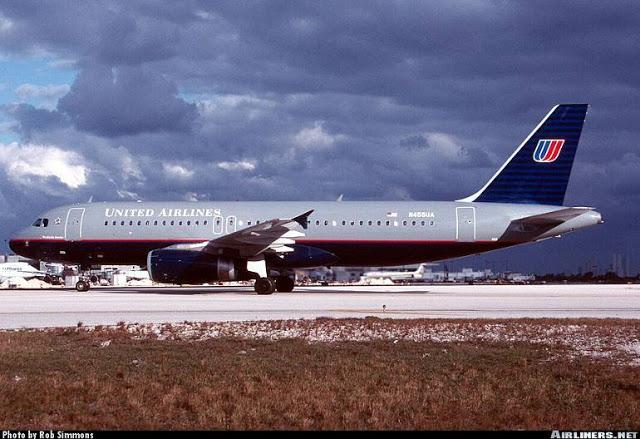
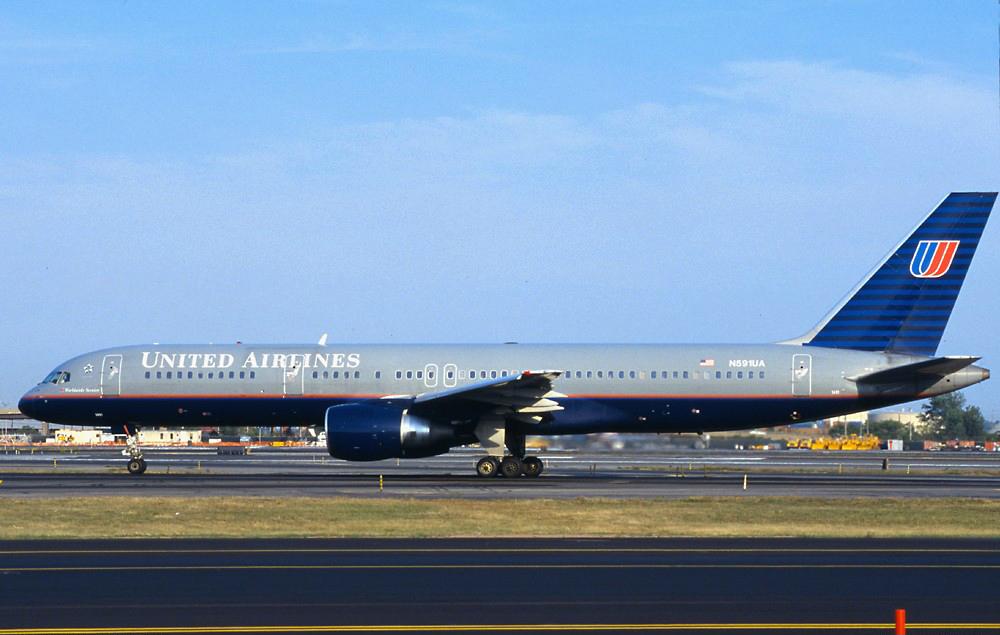
As part of the September 11, 2001 attacks, two of the four planes hijacked were United planes. One aircraft was N612UA, a Boeing 767–200 operating as United Airlines Flight 175, flown into the South Tower of the World Trade Center. The other was N591UA, a Boeing 757–222 operating as United Airlines Flight 93, which crashed in rural Pennsylvania after the passengers fought back against the hijackers, and was suspected to have been directed towards the United States Capitol building. These atrocities lead the airline to change its business in many ways and begin a complex reorganization process. United was in a worse position than before because it had failed to keep costs under control, possibly due to giving its pilots pay raises of up to 28% in the summer of 2000.
Coupled with a battered network, the post-9/11 decline in air travel and skyrocketing oil prices, the company lost $2.14 billion in 2001. In the same year United applied for a $1.5 billion loan guarantee from the federal Air Transportation Stabilization Board established in the wake of the September 11 attacks. When the IAM union failed to approve the loan guarantee the company was forced to seek debtor-in-possession financing from commercial sources to cover the expected future losses. Unable to secure additional capital, UAL Corporation filed for chapter 11 bankruptcy protection in December 2002. Blame for the bankruptcy had fallen on 9/11, which triggered financial crisis in all the major North American airlines, coupled with the economic slowdown that was underway.
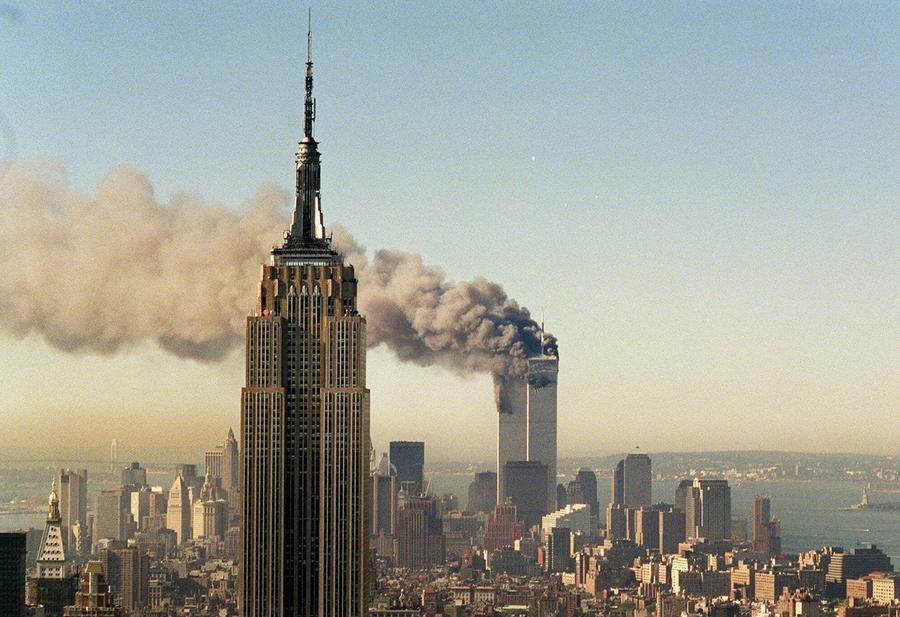
United continued operations during its bankruptcy, but was forced to cut its costs drastically. All city ticket offices in the US were closed down. The airline cancelled several existing and planned routes, and eliminated its entire Latin American gateway and flight crew base at Miami International Airport after March 1, 2004. Furthermore, they reduced their mainline fleet from 557 (before 9/11) to 460 aircraft. At the same time, the airline continued to invest in new projects.
On November 12, 2003, it launched a new low-cost carrier, Ted, to compete with other low-cost airlines. The SARS epidemic in 2003 depressed traffic on United's extensive Pacific network. The spikes in the price of jet fuel ate away remaining profits United made. United took advantage of its Chapter 11 status to negotiate hard-to-cut costs with employees, suppliers, and contractors, including cancellation of feeder contracts with United Express carriers Atlantic Coast Airlines (which became Independence Air) and Air Wisconsin(which became a US Airways Express carrier).
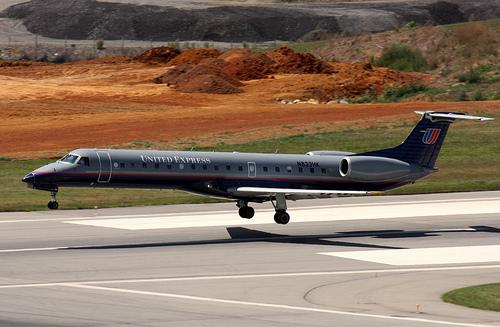
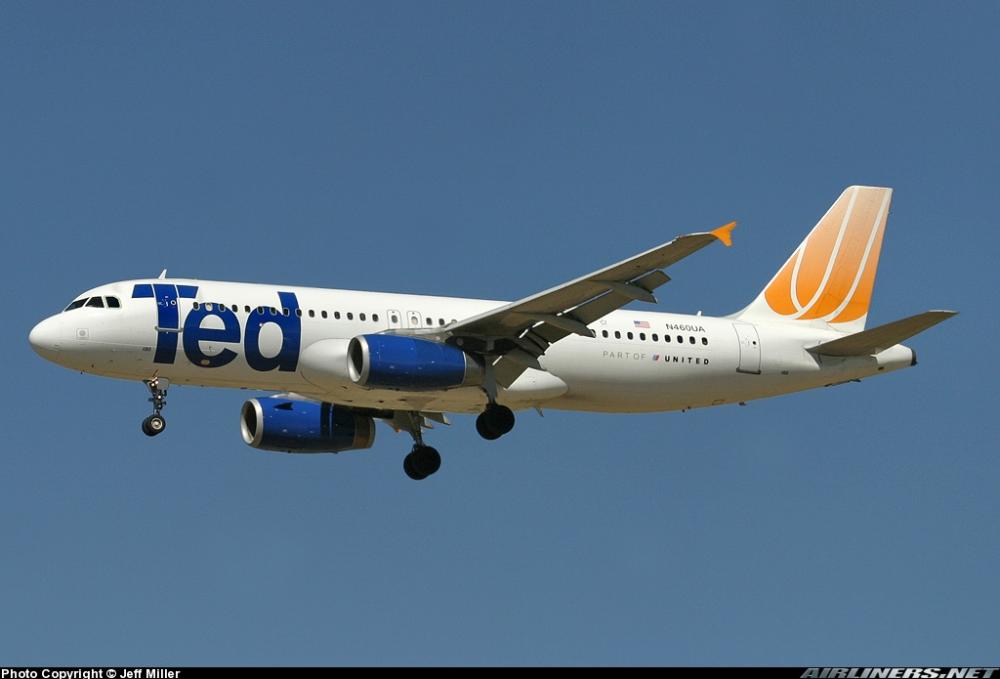
In February 2004, the airline introduced the new Blue and White livery, commonly called the 'Rising Blue' livery, with the Blue Tulip on the tail to coincide with a new advertising campaign. Financial pressure on the airline was heavy. On December 9, 2004, the airline made history when UA869, operated by a Boeing 747–400, landed at Ho Chi Minh City, Vietnam. The scheduled flight from San Francisco via Hong Kong (SFO–HKG–SGN) was the first by a U.S. airline since the end of the Vietnam War, when Pan Am halted service shortly before the fall of Saigon in 1975.
Originally slated to exit bankruptcy protection after 2½ years in the third quarter of 2005, United requested yet another extension in light of record-high fuel prices. On August 26, 2005, the bankruptcy court extended the airline's exclusive right to file a reorganization plan to November 1, although it also stated firmly this extension would be the last. The bankruptcy court approved the restructuring plan on January 20, 2006, clearing the way for United to exit bankruptcy. On February 1, 2006, United emerged from Chapter 11 bankruptcy protection under which it had operated since December 9, 2002, the largest and longest airline bankruptcy case in the history of the industry.
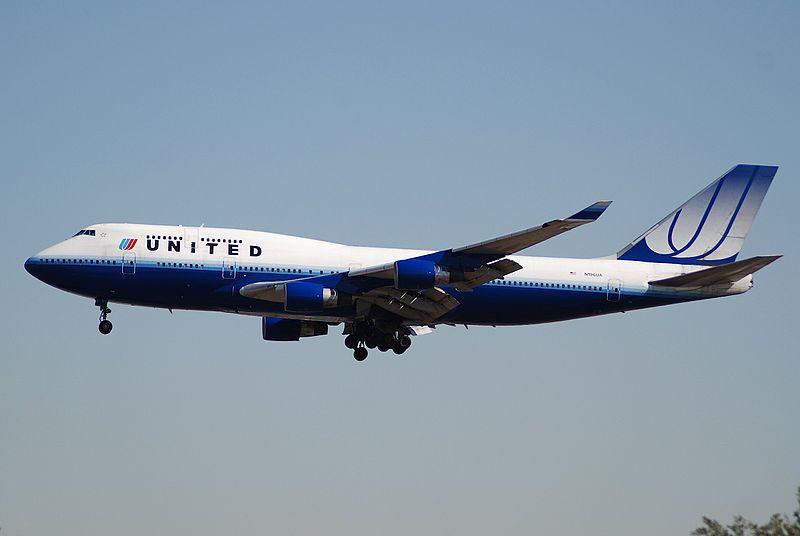
United's management called for consolidation in the industry and looked for a suitor in 2006. The Wall Street Journal revealed in late 2006, that Continental Airlines was in merger discussions with United. In the years following United’s exit from bankruptcy, two large financial firms, Bank of America and Fidelity Investments, accumulated shares to become the second largest owner with an 11 percent stake in the company. The surge in jet fuel prices caused disruption to United’s impending start of non-stop long-haul services. Though the FAA had already awarded the SFO to Guangzhou, China to United, they postponed the launch citing high fuel prices. Other long-haul city pairs, such as its 2009 application to fly between Los Angeles and Shanghai (which began May 2011) were denied by the FAA.
In May 2008, the American Customer Satisfaction Index scored United Airlines second-last among US-based airlines in customer satisfaction with a 21% decrease since the study began in 1994 and an 11% decrease over the previous year. On June 12, 2008, United announced it would charge $15 for the first checked bag, becoming the second United States airline to do so, the first being American Airlines. The charges, were created in an effort to offset high fuel prices. On June 28, 2008, United announced the cessation of several international routes including San Francisco-Nagoya and Chicago-Mexico City.
On June 4, 2008, United announced it would close its Ted unit, and reconfigure them for a return to mainline configuration, to compensate for the removal of United's Boeing 737s that were to be retired. That retirement plan included Boeing 737s and Boeing 747s, reducing the mainline fleet from 460 to 359 aircraft and furthering the airline's goal of cutting domestic capacity by 15 percent. On January 6, 2009, Ted ended operations converting its entire fleet into United mainline fleet. In January 2009, United announced a code-sharing agreement with Aer Lingus for flights between Washington Dulles and Madrid. Aer Lingus would operate the service, which is permitted under recent open skies agreements between the US and EU.
In 2009, United entered into an extensive partnership with Continental Airlines. This partnership included codeshare and frequent flyer agreements. As a part of the agreement, Continental left SkyTeam and joined the Star Alliance. On October 28, 2009, United flew its final Boeing 737 flight, as UA Flight 737. United's 737 retirement was particularly significant, as it was the U.S. launch customer of the 737 family in 1967, and operated variants of the type for 42 years. Despite this, the airline ended up regaining 737s with the merge with Continental in the near future.
On April 16, 2010, United resumed merger talks with Continental. The board of directors of both Continental and UAL Corporation's United Airlines reached an agreement to combine operations to create the world's largest airline on May 2, 2010. The combined carrier would take the United Airlines name but use Continental's logo and livery. On October 1, 2010, UAL Corporation (the parent company of United Airlines) completed its acquisition of Continental Airlines and changed its name to United Continental Holdings, Inc. Although the two airlines remain separate until the operational integration was completed (by mid-2012).
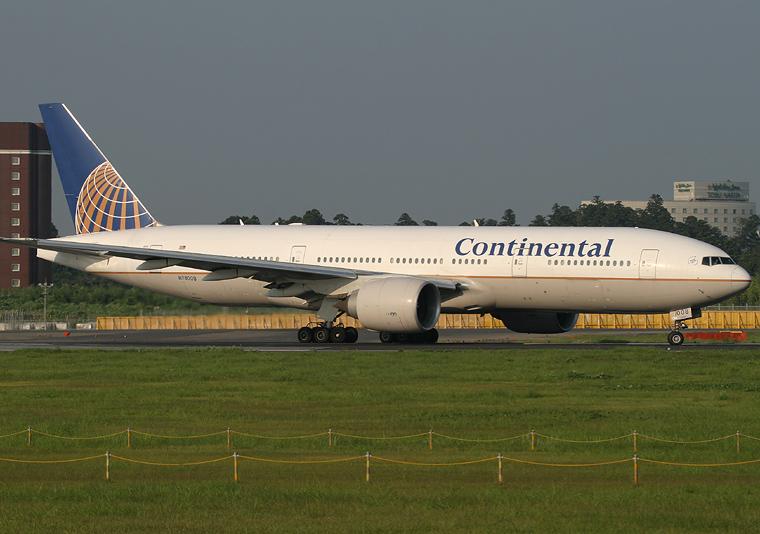
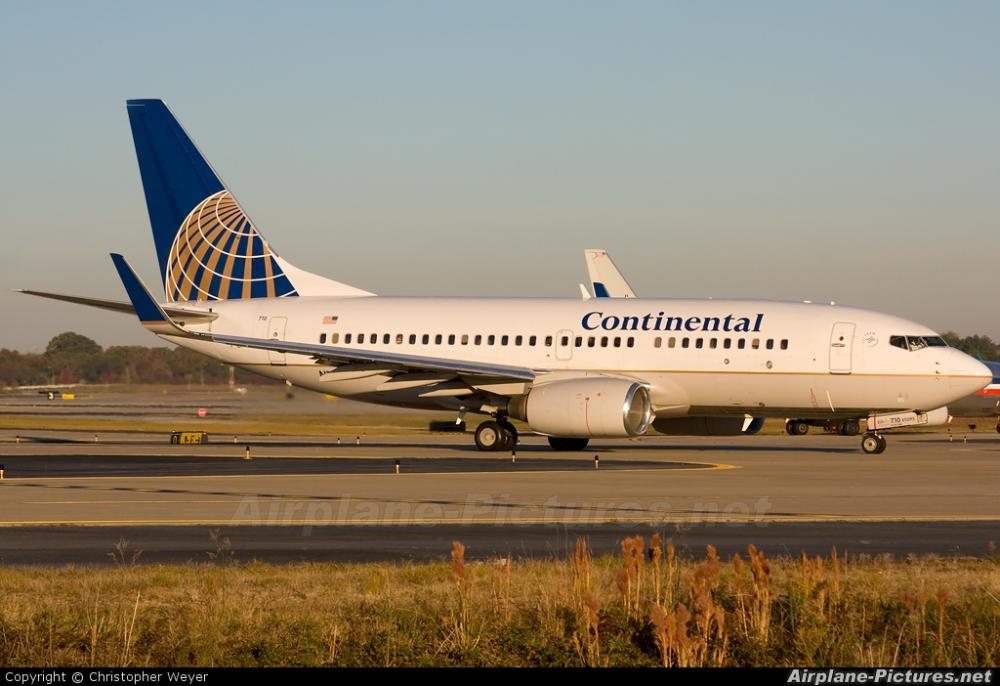
After the merger with Continental the process of restructuring began in order to combine seamlessly all the operations of the two airlines into one. After the fully integration and the award of one single air operator's certificate from the Federal Aviation Administration, the name of Continental disappeared from its planes and was relegated to the history books. The "new" United was born. The first few steps were to restructure its fleet and retire older models with new fuel efficient jets like the Dreamliners which started to arrive in 2012 with the Boeing 787-8 and soon after the 787-9.
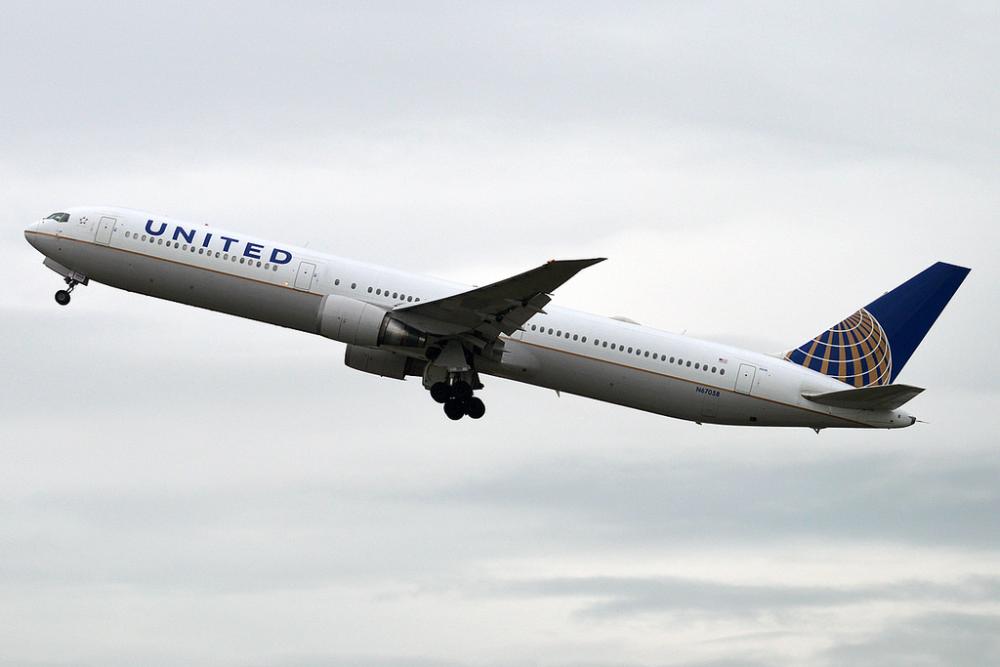
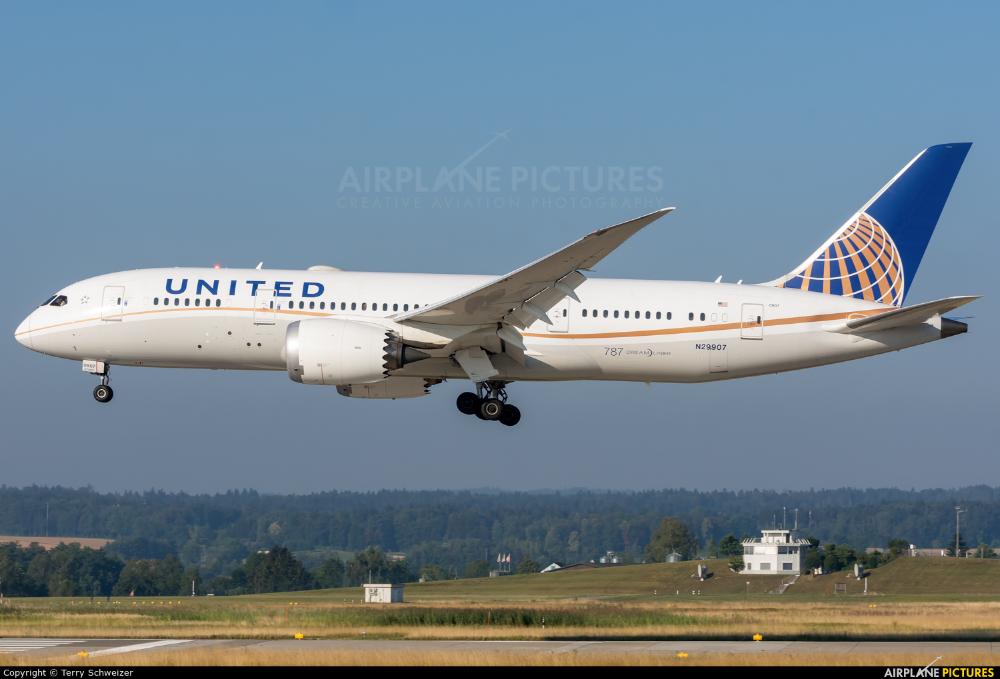
In July 2017, United announced an agreement with Boeing to convert 100 of the current 737 MAX 9 orders into 737 MAX 10s. With superior fuel efficiency and increased range, these aircrafts will elevate the performance and capabilities of the existing fleet and replace the B737-800/900ER.
In November 2017, United operated the last Boeing 747-400 flight into San Francisco. It operated these jets since the 1970's and have revolutionised the way we travel by air, however, with newer airframes on the market with operating with two engines instead of the 4, like the Jumbo, it made sense for the airlines to phase out the "queen of the skies" ir order to keep being competitive. Tha same year United saw the introduction of the larger Boeing 777-300ER for its long haul operations, as these aircraft took over the jumbo operated flights.
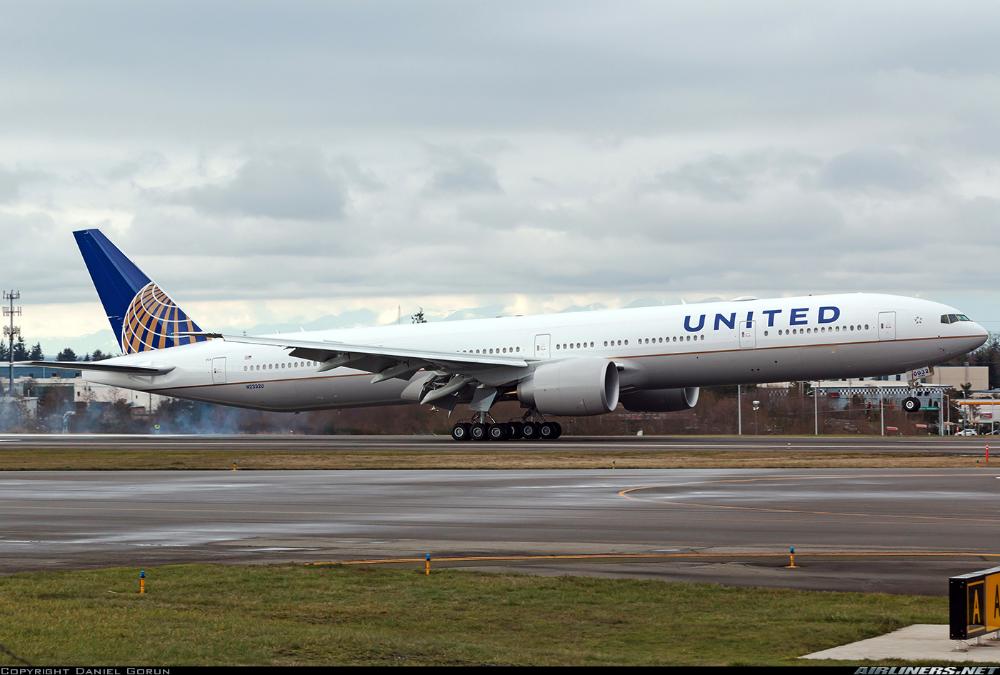
In January 2018, United planned to grow its company by adding between 4% and 6% to its passenger capacity that year and maintain that growth through 2020.In June 2018, United received the first of the Boeing 737 Max-9 new version short haul aircraft which would fly domestic and selected international routes to Canada and the Caribbean. Also, United became the first North American-based carrier to take delivery of the third iteration of the Dreamliner, the Boeing 787-10, which was delivered on the 5 of November 2018. United is also an operator of all previous Dreamliner models, the 787-8 and 787-9 which it received back from 2012.
In recent years, United has strengthened its position and provided its customers with a stronger competitive product, more connectivity and better services with the acquisition of new planes such as the Boeing 787-8/9/10 Dreamliners and Boeing 777-300ER for long haul operations as well as Boeing 737 Max-9/10 next generation aircraft for it's medium and short haul operations. It is currently one of the biggest airlines in the world with thousand of employees around all corners of the globe. With its extensive global network, thanks to its strong partnerships and alliances, United's code "UA" is present at nearly every airport around the world.
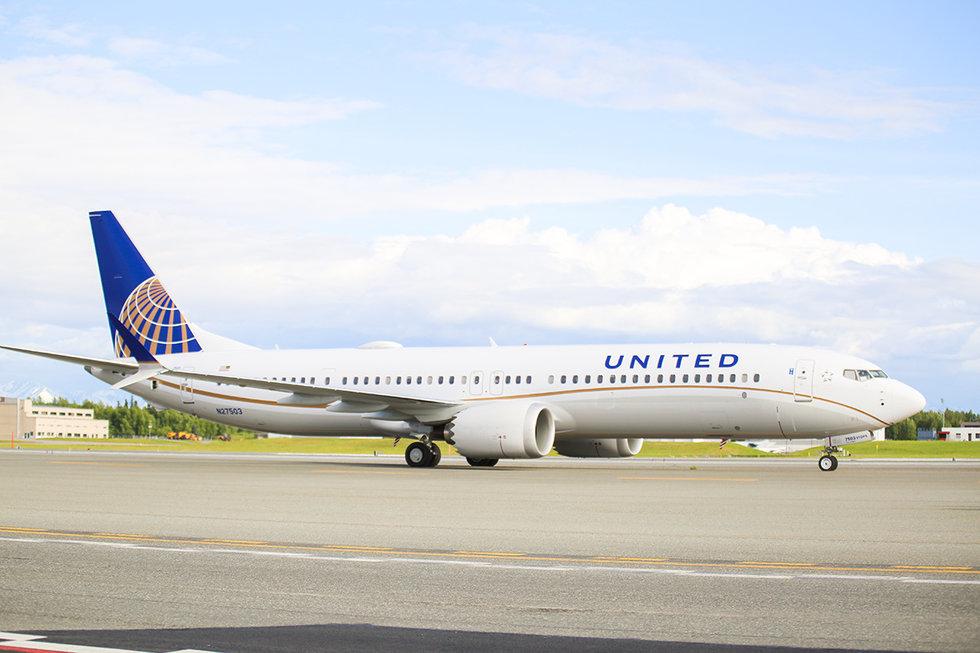
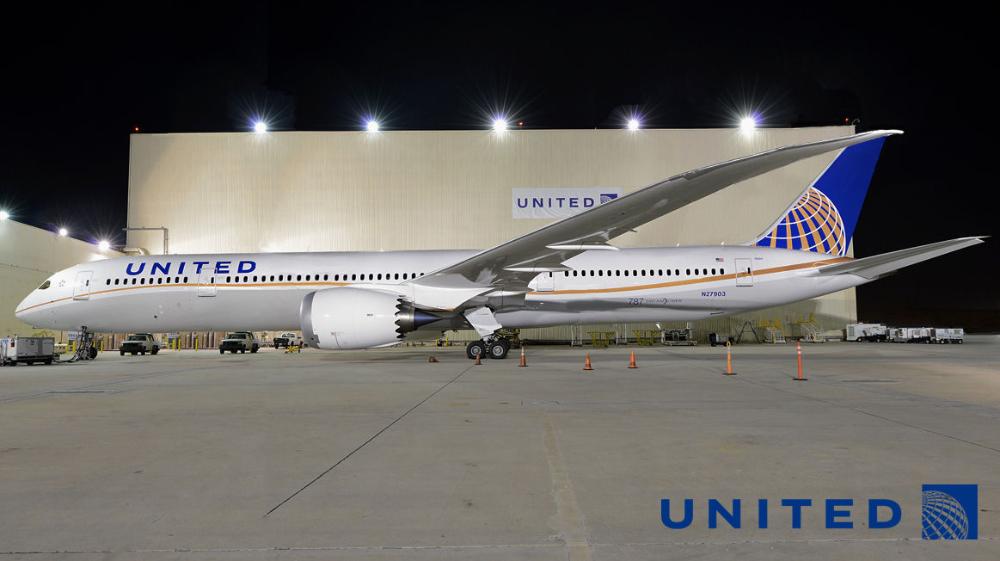
In spring 2019, United revealed a new colour scheme. Important for United, the globe will stay, painted prominently on the aircraft’s tail, though its color will change. The airline dropped the gold, an old Continental color, in much of its branding. For this livery update, United removed the gold from the tail, replacing it with a stylized blue logo, with light and dark shades. In another change, the airline is painting its name in blue lettering in much larger letters across the aircraft’s fuselage, with its its engines, now gray, in blue.
History source: Wikipedia.org + United.com
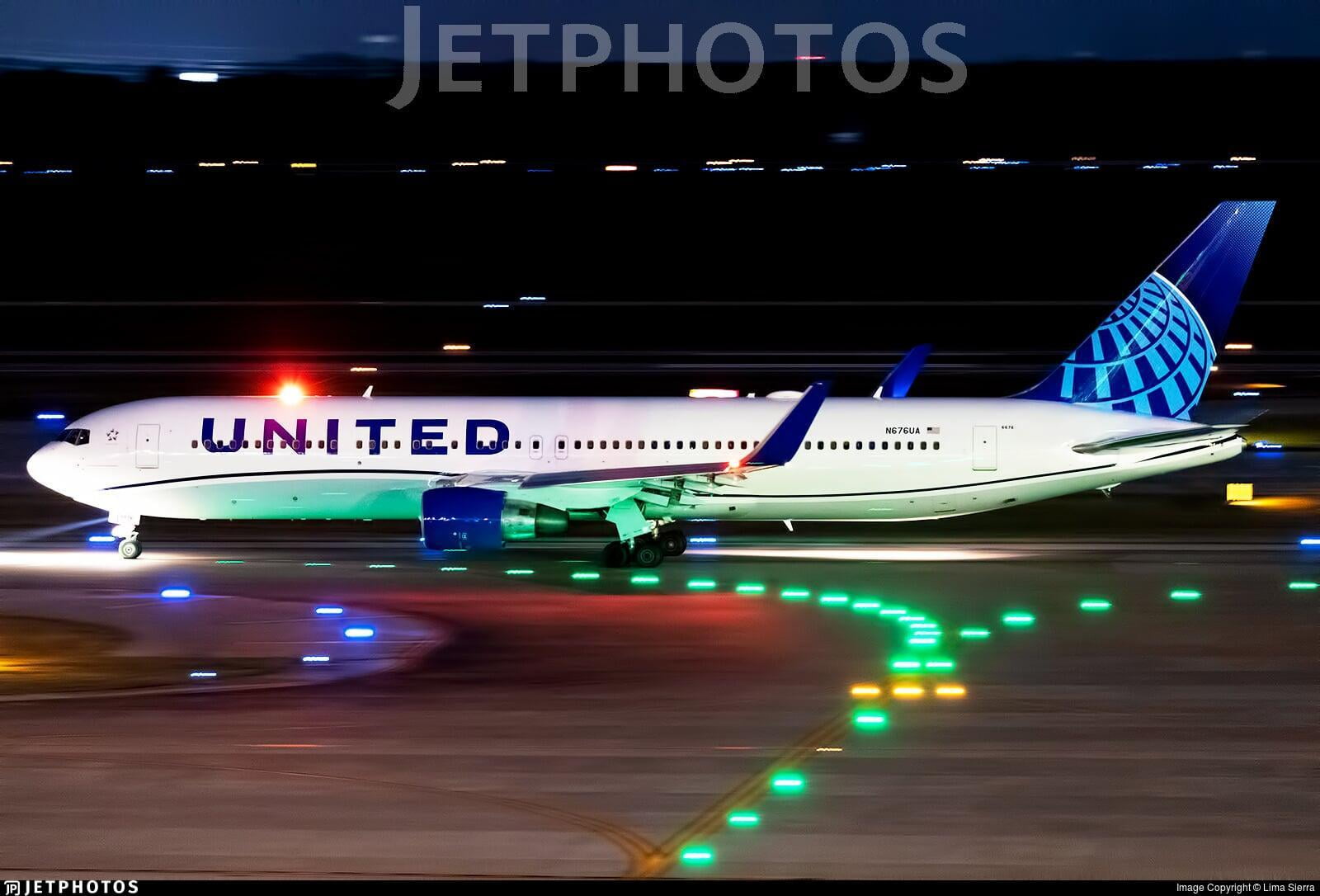
Operations and Destinations 🌍:
United Airlines is one of the largest carriers in the world and some of the few global airlines that can claim it flies to all 5 continents of the planet. It flies to 125 international destinations in 48 countries plus 106 domestic destinations in the USA. United currently operates seven hubs across the USA which serve it’s domestic, regional and long haul routes around the world. The main hubs are listed on the table below.
| Hubs | Description |
|---|---|
| ✈Chicago–O'Hare | United's largest hub and its hub for the Midwest. United's corporate headquarters are also in Chicago. |
| ✈Denver | United's hub for the central and western United States. |
| ✈Houston–Intercontinental | United's hub for the Southern United States and primary gateway to Latin America |
| ✈Los Angeles | United's secondary hub for the West Coast and gateway to Asia and Australia. |
| ✈ Newark | United's primary hub for the East Coast and a gateway to Europe, Latin America and Asia. United controls all of Terminal C and uses part of Terminal A for United Express Flights. |
| ✈San Francisco | United's primary hub for the West Coast and gateway to Asia and Australia |
| ✈Washington–Dulles | United's secondary hub for the East Coast and gateway to Europe. |
United Airlines, excluding its regional partners, flies to the following destinations*:
| Region 🗺️ | Destinations 🌍🌎🌏 |
|---|---|
| ✈U.S.A. (domestic) | Albany, Albuquerque, Anchorage, Atlanta, Austin, Baltimore, Billings, Bismarck, Boise, Boston, Bozeman, Buffalo, Burbank, Burlington, Charleston, Charlotte, Chicago, Cincinnati/Kentucky, Cleveland, Colorado Springs, Columbus, Dallas, Denver, Des Moines, Detroit, Eugene, Everett, Fairbanks, Fort Lauderdale, Fort Myers, Grand Rapids, Greensboro, Harrisburg, Hartford, Hilo, Honolulu, Houston, Indianapolis, Jackson Hole, Jacksonville, Kahului, Kansas City, Knoxville, Kona, Las Vegas, Lihue, Los Angeles, McAllen, Memphis, Miami, Milwaukee, Minneapolis, Montrose, Nashville, New Orleans, New York City, Newark, Norfolk, Oklahoma City, Omaha, Ontario, Orange County, Orlando, Palm Springs, Philadelphia, Phoenix, Pittsburgh, Portland, Maine, Portland, Oregon, Providence, Raleigh, Reno, Richmond, Rochester, Minnesota, Rochester, New York, Sacramento, Saint Thomas, Salt Lake City, San Antonio, San Diego, San Francisco, San Jose, Sarasota, Seattle, Sioux Falls, Spokane, St. Louis, Tampa, Traverse City, Tucson, Tulsa, Vail, Washington, D.C., West Palm Beach, Wichita, Wilmington |
| ✈Canada and Mexico | Canada: Calgary, Edmonton, Toronto, Vancouver Mexico: Cancún, Cozumel, Guadalajara, Ixtapa, León, Mérida, Mexico City, Puerto Vallarta, San José del Cabo |
| ✈The Caribbean and Central America (except Mexico) | Aguadilla, Antigua, Belize City, Grand Cayman, Guatemala City, Hamilton, Havana, Kralendijk, Kwajalein, Majuro, Managua, Montego Bay, Nassau, Oranjestad, Panama City, Philipsburg(Sint Maarten), Port of Spain, Providenciales, Puerto Plata, Punta Cana, Roatán, Saint Kitts, San Juan, San Pedro Sula, Santiago de los Caballeros, Santo Domingo, St. Lucia, Tegucigalpa |
| ✈South America | Bogotá, Buenos Aires, Liberia, Lima, Quito, Rio de Janeiro, San José, San Salvador, Santiago, São Paulo |
| ✈Asia | Beijing, Chengdu, Delhi, Fukuoka, Hong Kong, Manila, Mumbai, Nagoya, Osaka, Seoul, Shanghai, Singapore, Taipei, Tokyo |
| ✈ Europe | Amsterdam, Athens, Barcelona, Berlin, Brussels, Dublin, Edinburgh, Frankfurt, Geneva, Glasgow, Lisbon, London, Madrid, Manchester, Milan, Munich, Naples, Paris, Porto, Prague, Reykjavik, Rome, Shannon, Stockholm, Venice, Zürich |
| ✈The Middle East | Tel Aviv |
| ✈The Pacific | Auckland, Melbourne, Sydney, Chuuk, Guam, Koror, Kosrae, Papeete, Pohnpei, Yap |
Additionally, since 1985, United Express has been operating feeder flights from smaller airports into United’s main hubs. This has been made possible thanks to a number of agreements with smaller commuter airlines which operate on behalf of United Airlines. Due to the protection of the smaller airlines, by the government, each year the regional routes are put up for bidding by United and are awarded to the regional partners, which operate independently but with the major backing or logistics of the parent airline.
These airlines are Air Wisconsin, CommutAir, ExpressJet, GoJet Airlines, Mesa Airlines, Republic Airways, SkyWest Airlines and Trans States Airlines.








The regional partners of United Airlines fly to the following destinations*:
| Region 🗺️ | Destinations 🌍🌎🌏 |
|---|---|
| ✈Air Wisconsin | United States: Akron, Albany, Allentown, Appleton, Birmingham, Buffalo, Burlington, Cedar Rapids, Centre County, Champaign, Charleston, Charlottesville, Chattanooga, Chicago, Cleveland, Columbia, Columbia, Columbus, Dayton, Denver, Des Moines, Dulles, Erie, Evansville, Fargo, Fayetteville, Fayetteville, Flint, Grand Rapids, Green Bay, Greensboro, Greenville, Huntsville, Indianapolis, Jackson, Kalamazoo, Kansas City, Knoxville, Lansing, Lexington, Lincoln, Louisville, Madison, Manchester, Milwaukee, Mosinee, Nashville, Norfolk, Oklahoma City, Omaha, Pensacola, Peoria, Philadelphia, Portland, Providence, Rapid City, Richmond, Roanoke, Rochester, Rochester, Rock City, Savannah, Scranton, Sioux Falls, South Bend, Springfield, St Louis, Syracuse, Traverse City, Tulsa, White Plains, Wichita, Wilmington. |
| ✈CommutAir | United States: Albany, Baltimore, Binghamton, Buffalo, Charleston, West Virginia, Charlottesville, Cleveland, Fayetteville, Greenville/Spartanburg, Hartford, Ithaca, Jacksonville, Manchester, Nantucket, Newark, Norfolk, Providence, Roanoke, Rochester, State College, Syracuse, Washington, D.C., Wilkes-Barre/Scranton |
| ✈ExpressJet | United States: Akron, Albany, Albuquerque, Alexandria, Allentown, Amarillo, Appleton, Asheville, Atlanta, Atlantic City, Austin, Baltimore, Baton Rouge, Billings, Birmingham, Bismarck, Boston, Brownsville, Buffalo, Burlington, Cedar Rapids, Charleston, Charleston, Charlotte, Chicago, Cincinnati, Ohio area, Cleveland, College Station, Colorado Springs, Columbia, Columbus, Corpus Christi, Dallas–Fort Worth, Dayton, Del Rio, Denver, Des Moines, Detroit, Dickinson, Durango, El Paso, Erie, Evansville, Fargo, Fayetteville, Flint, Fort Hood, Fort Walton Beach, Grand Junction, Grand Rapids, Green Bay, Greensboro, Greenville/Spartanburg, Gulfport/Biloxi, Gunnison, Harlingen, Harrisburg, Hartford, Hobbs, Houston, Huntsville, Indianapolis, Jackson, Jacksonville, Kansas City, Knoxville, Lafayette, Lake Charles, Lansing, Laredo, Lexington, Lincoln, Little Rock, Los Angeles, Louisville, Lubbock, Madison, Manchester, McAllen, Memphis, Midland, Milwaukee, Minneapolis/St. Paul, Minot, Mobile, Moline, Monroe, Montrose/Telluride, Myrtle Beach, Nashville, New Orleans, New York City, Newark, Norfolk, Oklahoma City, Omaha, Panama City, Pensacola, Peoria, Philadelphia, Phoenix, Pittsburgh, Portland, Providence, Raleigh/Durham, Rapid City, Richmond, Roanoke, Rochester, San Antonio, Sarasota/Bradenton, Savannah, Shreveport, Sioux Falls, South Bend, Springfield, St. Louis, State College, Syracuse, Traverse City, Tulsa, Tyler, Waco, Washington, D.C. area, Wausau, Wichita, Wilkes-Barre, Williston Canada: Halifax, Kelowna, Montréal, Ottawa, Quebec City, Toronto, Winnipeg Mexico: Acapulco, Aguascalientes, Chihuahua, Guadalajara, Ixtapa-Zihuatanejo, León, Manzanillo, Mazatlán, Mexico City, Monterrey, Morelia, Oaxaca, Puebla City, Puerto Vallarta, San José del Cabo, San Luis Potosí, Querétaro, Tampico, Veracruz |
| ✈GoJet Airlines | United States: Albany, Albuquerque, Baltimore, Casper, Chicago, Cincinnati, Ohio area, Colorado Springs, Denver, Detroit, Greensboro, Hayden/Steamboat Springs, Jacksonville, Kansas City, Manchester, Norfolk, Oklahoma City, Omaha, Portland, Providence, Rochester, San Antonio, St. Louis, Syracuse, Tulsa, Vail, Washington, D.C. Canada: Montréal, Toronto |
| ✈Mesa Airlines | United States: Akron, Albuquerque, Allentown, Appleton, Atlanta, Austin, Binghamton, Birmingham, Bloomington, Boston, Buffalo, Cedar Rapids, Charlotte, Chicago, Cleveland, Columbia, Columbus, Des Moines, Detroit, Flint, Fort Myers, Fort Wayne, Grand Rapids, Green Bay, Greensboro, Hartford, Huntsville, Indianapolis, Jacksonville, Kansas City, Lansing, Manchester, Memphis, Miami, Milwaukee, Minneapolis/St. Paul, Moline, Myrtle Beach, Nashville, New York City, Newark, Norfolk, Oklahoma City, Philadelphia, Pittsburgh, Portland, Providence, Raleigh/Durham, Rapid City, Roanoke, Rochester, Saginaw, Savannah, Sioux Falls, South Bend, Springfield, Traverse City, Washington, D.C., Wausau, West Palm Beach, Wilkes-Barre |
| ✈Republic Airways | United States:Albuquerque, Aspen, Atlanta, Austin, Billings, Buffalo, Cedar Rapids, Charlotte, Chicago, Columbus, Dallas/Fort Worth, Denver, Des Moines, Durango, Fort Myers, Grand Junction, Hartford, Houston, Indianapolis, Jackson Hole, Jacksonville, Kansas City, Key West, Miami, Minneapolis/St. Paul, Montrose, Myrtle Beach, New Orleans, Norfolk, Oklahoma City, Omaha, Pittsburgh, Raleigh/Durham, Rapid City, Rochester, San Antonio, South Bend, Washington, D.C., White Plains, Wichita Canada: Edmonton, Halifax, Montréal, Ottawa, Toronto |
| ✈SkyWest Airlines | United States: Akron/Canton, Albany, Albuquerque, Appleton, Aspen, Austin, Bakersfield, Billings, Birmingham, Bismarck, Boise, Bozeman, Burbank, Burlington, Casper, Cedar Rapids, Charleston, Chicago, Chico, Clarksburg, Cleveland, Cody, Colorado Springs, Coos Bay, Covington, Crescent City, Dallas/Fort Worth, Dayton, Denver, Des Moines, Detroit, Devils Lake, Duluth, Durango, Eau Claire, El Paso, Eugene, Eureka/Arcata, Fargo, Fayetteville/Bentonville/Highfill, Fort Wayne, Fresno, Gillette, Grand Junction, Grand Rapids, Great Falls, Green Bay, Hancock/Houghton, Hartford, Hayden/Steamboat Springs, Hays, Helena, Houston, Huntsville, Idaho Falls, Imperial, Indianapolis, Jacksonville, Kalamazoo, Kalispell, Kansas City, Knoxville, Lansing, Laramie, Las Vegas, Lexington, Lincoln, Little Rock, Los Angeles, Louisville, Madison, Mammoth Lakes, Medford, Memphis, Midland/Odessa, Milwaukee, Minneapolis/St. Paul, Minot, Missoula, Moline, Monterey, Montrose/Telluride, Muskegon, Nashville, Norfolk, North Charleston, Oakland, Oklahoma City, Omaha, Ontario, Oxnard, Paducah, Palm Springs, Pasco, Peoria, Phoenix, Pittsburgh, Portland, Providence, Pueblo, Raleigh-Durham, Rapid City, Redding, Redmond, Reno/Lake Tahoe, Rock Springs, Sacramento, Saginaw, Salt Lake City, San Antonio, San Diego, San Francisco, San Jose, San Luis Obispo, Santa Ana,, Santa Barbara, Savannah, Seattle-Tacoma, Sioux Falls, South Bend, Spokane, Springfield, Springfield/Branson, St. Louis, Sun Valley, Syracuse, Traverse City, Tucson, Tulsa, Wausau, Wichita, Yuma. Canada: Calgary, Edmonton, Ottawa, Toronto, Vancouver, Victoria, Winnipeg |
| ✈Trans States Airlines | United States: Albany, Albuquerque, Burlington, Casper, Charleston, Chicago, Cleveland, Covington, Dayton, Denver, Detroit, Evansville, Greensboro-High-Point-Winston-Salem, Greer, Harrisburg, Knoxville, Madison, Manchester, Milwaukee, Moline, Nashville, Newark, Oklahoma City, Omaha, Philadelphia, Pittsburgh, Providence, Raleigh-Durham, Richmond, Roanoke, Rochester, Santa Fe, Savannah, South Bend, Springfield, St. Louis, Syracuse, Tulsa, Washington, DC |
*Destination list is for reference only. Please check directly with the airline for updates.
*Note some destinations are only seasonal.*Correct info as of Jan 2019.
Fleet ✈️:
United has a strong fleet of over 770 aircraft. It's continuously upgrading and introducing new air-frames into its fleet as older models are retired or sold on. Since its formation, United has always taken on and inherited many planes when it bought out other airlines and went into mergers, specially with Continental airlines in 2012. Therefore it's fleet is one of the biggest in the country, it operates a mix of Airbus and Boeing aircraft for its short haul flights and domestic operations. It's long haul flights are operated exclusively with Boeing products. (until Airbus A350-900 are delivered in 2022).
Not to forget, is the number of regional airlines which operate on behalf of United, they operate a fleet of Bombardier and Embraer aircraft for it's thinner domestic routes and some international routes to Canada.
Below is the fleet* of United, including those by its affiliate regional airlines:
| Network 🌐 | Aircraft ✈️ |
|---|---|
| ✈Regional | Bombardier CRJ-200/700, Embraer ERJ-145/170/175 |
| ✈Short and Medium Haul (Domestic and International) | Airbus A319, A320. Boeing 737-700/800, B737 Max 9, Max 10 (Max planes on hold pending recertification), B757-200/300, B767-300ER, B777-200, B787-8/9 |
| ✈Long Haul | Airbus A350 (from 2022). Boeing 767-300ER, B767-400, B777-200/200ER/300ER, B787-8/9/10 |
*Correct fleet info as of Jan 2019.
United Airlines Photo Slide 📷:
United Airlines Safety Video (B787-9) 🎬:
Reviews ⭐:
 |  |
|---|---|
| ✅One of the Oldest airline brand and companies in the world with a high reputation and company values. | 👎 Some Aircraft can be outdated due to the massive fleet size which United uses |
| ✅ Member of the Star Alliance for mileage redemption. | 👎Use of single aisle aircraft for long-haul flights to selected destinations. |
| ✅United Prides itself in good customer service, customer satisfaction and loyalty programmes. | 👎 Meal selection on board is basic. (Economy) |
| ✅Excellent Airline for choice of domestic connections and regional flights in the USA. | 👎 An informal customer service approach on some flights. |
| ✅Online check-in and free seat selection. | |
| ✅Good Quality Lounges around the World (Operated with Star Alliance Partners). |






.png)